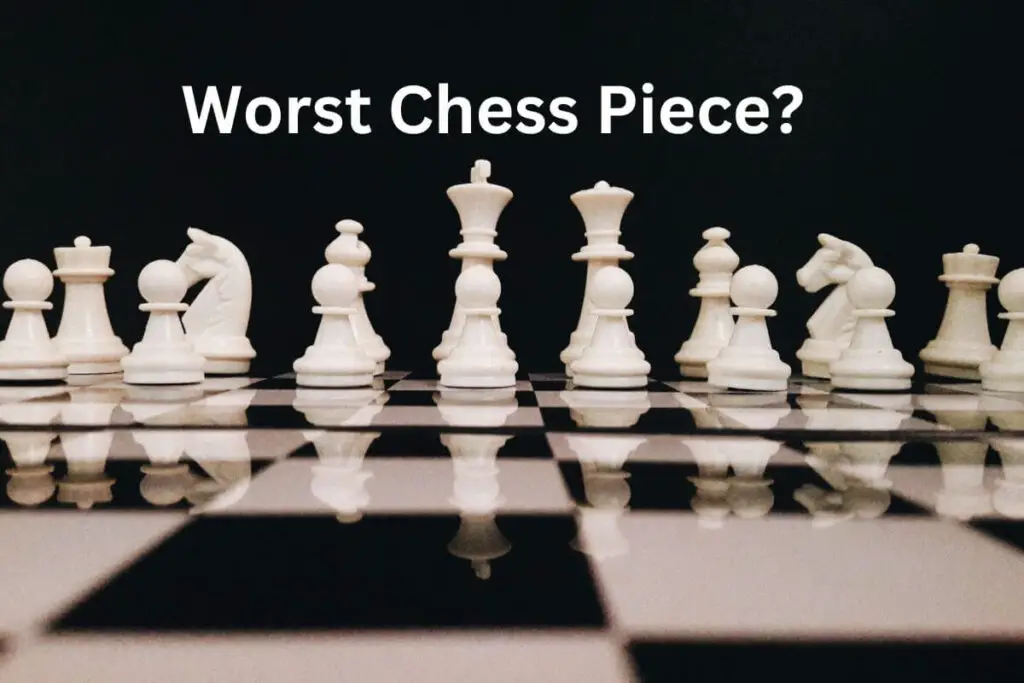The worst chess piece on the chess board is the pawn. The pawns are lined on the 2nd rank of the chess board at the start of a match (7th rank for black). They help to protect the major and minor pieces but more importantly the king.
So why are the pawns the worst chess piece of the entire royal family? Stick around to find out.
Why Is The Pawn The Worst Chess Piece?
The power of a chess piece is determined by the number of squares it can move to on a single turn, or the scope it controls on the board. A pawn can only move one square forward compared to the queen that can move any number of squares in any direction in a straight line.
Therefore, compared to the queen, the pawn is extremely weak and not as flexible, since it can only move one square forward.
The pawn is the worst chess piece because it can only move one square forward or 2 squares forward on it’s first move. It captures diagonally one square forward to the left or right. As a result, the pawn only controls 2 squares which is the smallest of all the other pieces.
Below is a table showing the number of squares each chess piece controls from the center of the chess board
| Chess Piece | Number of squares controlled |
| Pawn | 2 |
| King | 8 |
| Queen | 27 |
| Bishop | 13 |
| Knight | 8 |
| Rook | 14 |
Special Pawn Moves
En Passant
While the pawn is the least valued chess piece, it has the ability to perform special moves over the board, unlike the other pieces.
En passant is a special chess rule that allows a pawn to capture an opponent’s pawn that has just moved two squares forward from its starting position. The term “en passant” is French for “in passing,” and the rule is designed to prevent a pawn from avoiding capture when it moves two squares forward.
Here’s how the en passant rule works:
- The opportunity to capture en passant only arises when an opponent’s pawn advances two squares from its starting position to land directly beside your pawn.
- To capture en passant, you must immediately respond on the next move. Move your pawn diagonally forward to the square that the opponent’s pawn would have occupied had it moved only one square forward. This captures the opponent’s pawn as if it had moved one square forward.
- En passant captures are only possible on the move immediately following the opponent’s pawn’s two-square advance. If you don’t capture en passant on the next move, the opportunity is lost.
- En passant captures are optional. You can choose to capture en passant or make a different move if it’s your turn and the opportunity arises.
En passant is a relatively uncommon rule, but it’s important to understand if you want to play chess competitively or at an advanced level. It helps prevent pawns from avoiding capture and adds depth to pawn structure considerations in the game.
Pawn Promotion
Pawn promotion is a fundamental and crucial rule in chess that allows a pawn to be promoted to a more powerful piece when it reaches the opponent’s back rank (the 8th rank for White and the 1st rank for Black). When a pawn reaches the promotion square, the player must choose to promote it to either a queen, rook, knight, or bishop, regardless of how many of these pieces are already on the board.
Here’s how pawn promotion works:
- When a pawn reaches the opponent’s back rank, it must be promoted on the next move. This is mandatory; you cannot keep the pawn as a pawn.
- The player has the choice of promoting the pawn to one of the following pieces:
- Queen: This is the most common choice, as the queen is the most powerful piece in chess, capable of moving in any direction.
- Rook: Promoting to a rook can be useful for situations where you need additional rooks for attacking or defending.
- Knight: Promoting to a knight can be strategically valuable, as knights have unique movement patterns that can surprise your opponent.
- Bishop: Promoting to a bishop can be helpful if you want to maintain or acquire additional bishops on the board.
- The choice of the promoted piece is entirely up to the player, and they can choose the piece that best suits their current position and strategy.
- Once the player has made their choice, the pawn is replaced with the selected piece on the promotion square. The newly promoted piece can then move and capture as per its own rules in subsequent moves.
Pawn promotion often plays a critical role in chess, as it can lead to the creation of multiple powerful pieces on the board, significantly impacting the balance of power and tactics. It’s an essential aspect of endgame strategy and can lead to exciting and decisive moments in the game.
Final Thoughts
In conclusion, among all the chess pieces, the least powerful is undoubtedly the pawn. Pawns are the foot soldiers of the chessboard, with limited movement options and attack capabilities.
They move only forward, capture diagonally, and can only advance two squares on their first move. Pawns lack the versatility, mobility, and range of the other chess pieces like knights, bishops, rooks, and queens.
While they may seem modest individually, pawns play a critical role in shaping the chessboard, controlling key squares, and enabling the more powerful pieces to maneuver effectively.
Their promotion to more potent pieces upon reaching the opponent’s back rank, though infrequent, adds an element of strategy and potential for transformation to these seemingly humble chess soldiers.
Thus, while pawns may be the least powerful on their own, their significance in the grand strategy of chess cannot be underestimated.


